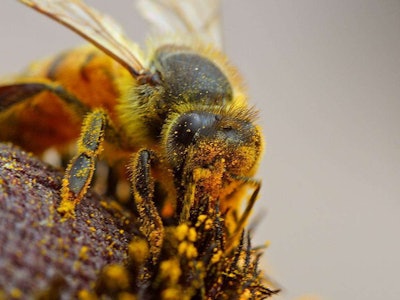 Researchers found the bees preferred the infected plants’ scent.
Researchers found the bees preferred the infected plants’ scent.Natural instincts may steer animals away from some dangers in their environment, but recent studies conducted by the University of Cambridge have found that bumblebees prefer pollinating certain infected plants.
The cucumber mosaic virus (CMV) infects a wide variety hosts, including cucumbers, squash, melons, peppers, celery, carrots, beets and tomatoes. Because CMV is one of the most prevalent pathogens plaguing tomato plants, that’s the vegetable on which the researchers chose to focus.
Through the study, scientists discovered that the virus alters the scent emitted by the plants, and it’s the scent that attracted bumblebees more to infected plants than healthy ones.
After growing plants in individual containers, air containing emissions from the CMV-infected plants was collected along with air samples from control plants. A mass spectrometer was able to detect the change in the volatiles (or degree of vaporization) between the plants and the bees could tell the difference too.
In a “flight arena” established by the researchers, bumblebees were released individually in the botanic garden and timed. Without exception, they headed to the infected plants first and spent more time there.
Further examination revealed that the virus produces a factor called 2b that allows it to reprogram genetic expression in tomato plants and change the scent.
“Better understanding the natural chemicals that attract bees could provide ways of enhancing pollination and attracting bees to good sources of pollen and nectar – which they need for survival,” the principle investigator, Dr. John Carr, Head of Cambridge’s Virology and Molecular Plant Pathology group, told Phys.org.
The scientists theorize that CMV has developed the scent-changing ability as a way to pay back its host, which the virus causes to produce smaller, poor-tasting fruits with fewer seeds.
“The virus is rewarding disease-susceptible plants, and at the same time producing new hosts it can infect to prevent itself from going extinct,” Carr said, “an example, perhaps, of what’s known as symbolic mutualism.”
While bees do not transmit CMV – aphids do that – they can spread the pollen of plants that are susceptible and reduce the chances of a virus-resistant strain’s developing. Mathematical models indicate that the pollinator bias allows the susceptibility to CMV to carry on for generations.
“We were surprised that bees liked the smell of the plants infected with the virus – it made no sense,” Carr said. “You’d think pollinators would prefer a healthy plant. However, modelling suggested if pollinators were biased toward diseased plants in the wild, this could short-circuit natural selection for disease resistance.”










